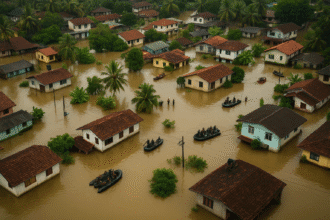Introduction: The Spirit of Navratri & Dussehra
Every year, as the monsoon retreats and autumn begins, India lights up with two of its most powerful festivals: Navratri and Dussehra. Celebrated across the country with devotion, dance, music, and mythological storytelling, these festivals are more than just rituals — they are living traditions that teach us about courage, discipline, and the ultimate triumph of good over evil.
But here’s the interesting part: while the eastern part of India celebrates Dussehra as Goddess Durga’s victory over Mahishasura, the northern and western regions link the same day to Lord Rama’s victory over Ravana. This duality is what makes Navratri and Dussehra one of the most fascinating cultural celebrations in India.
Also read – Was Mahabharata a Nuclear War?
The Story of Navratri: The Battle of Durga and Mahishasura
According to the Devi Mahatmya in the Markandeya Purana, a buffalo demon named Mahishasura received a boon that no man or god could kill him. Empowered by arrogance, he terrorized the heavens and earth, defeating the devas and taking control of the universe.
Unable to stop him, the gods combined their powers to create a supreme feminine force: Goddess Durga. Armed with weapons from each deity and riding a lion, she fought Mahishasura for nine nights and ten days. On the tenth day, she finally slayed him.
This victory is celebrated as Vijayadashami or Dussehra, and the nine nights leading up to it are observed as Navratri, each night honoring one form of the goddess (Nava Durga).
The Story of Dussehra: Rama’s Victory Over Ravana
In contrast, northern India remembers Dussehra as the day Lord Rama defeated Ravana, the ten-headed king of Lanka, as described in the epic Ramayana.
Ravana had kidnapped Rama’s wife, Sita, leading to a great war. With the blessings of Goddess Durga and the help of Hanuman and his army, Rama shot the final arrow into Ravana on the day of Vijayadashami.
This is why in cities like Delhi, Varanasi, and Lucknow, huge effigies of Ravana, Meghnath, and Kumbhakarna are burned every year — symbolizing the destruction of arrogance, ego, and evil.
Navratri Across India: Regional Celebrations
What makes Navratri truly unique is that every region in India has its own way of celebrating:
- Gujarat & Mumbai: Known for Garba and Dandiya Raas, where communities gather in colorful attire, dancing late into the night around the image of the Goddess.
- West Bengal, Assam & Odisha: Durga Puja is the heart of Navratri, with elaborate pandals, artistic idols, dhunuchi dance, and sindoor khela on Vijayadashami.
- Tamil Nadu, Karnataka & Andhra Pradesh: Families set up Golu doll displays, representing gods, goddesses, and mythological stories.
- Himachal Pradesh (Kullu Dussehra): A week-long fair that brings together deities from different villages in a grand procession.
- Delhi & Uttar Pradesh: Ram Leela performances dramatize the Ramayana, culminating in the burning of Ravana’s effigies.
This diversity shows how one festival can carry multiple meanings yet unite people in celebration.
The 9 Colors of Navratri: Symbolism and Daily Guide
One of the most beautiful traditions of Navratri is the practice of wearing a different color each day. Each color is tied to one of the nine forms of Goddess Durga and carries symbolic meaning.
Navratri 2025 Color Guide:
- Day 1 – Grey: Represents balance, stability, and positivity.
- Day 2 – Orange: Symbolizes energy, joy, and enthusiasm.
- Day 3 – White: Associated with peace, purity, and calmness.
- Day 4 – Red: A mark of courage, passion, and strength.
- Day 5 – Royal Blue: Stands for prosperity, richness, and growth.
- Day 6 – Yellow: Radiates joy, knowledge, and clarity.
- Day 7 – Green: Symbolizes renewal, harmony, and fertility.
- Day 8 – Peacock Green/Blue: Represents hope, grace, and new beginnings.
- Day 9 – Purple/Pink: A sign of ambition, dignity, and self-respect.
Many devotees follow these colors during fasting and prayers, while youngsters enjoy coordinating their outfits to celebrate tradition in a modern way.
Rituals of Navratri: Devotion Meets Discipline
- Fasting (Vrat): Devotees often fast by eating only satvik food like fruits, milk, and kuttu flour dishes.
- Kanya Pujan: On the eighth or ninth day, young girls (representing the goddess) are worshipped and offered food and gifts.
- Garba & Dandiya: Community dances to devotional songs, blending devotion with celebration.
- Durga Puja Rituals: Aarti, pushpanjali, bhog offerings, and immersion ceremonies mark the goddess’s symbolic return to her heavenly abode.
These rituals are not just spiritual but also a way of cultivating self-discipline, mindfulness, and community bonding.
Modern Relevance: Why Navratri and Dussehra Matter Today
Even in the 21st century, Navratri and Dussehra carry deep relevance:
- Personal Battles: Just like Durga defeated Mahishasura and Rama defeated Ravana, these festivals remind us that our personal struggles — whether against fear, stress, or negativity — can also be overcome.
- Cultural Unity: Despite different legends, every region celebrates the same values of courage, devotion, and victory of truth.
- Sustainability Shift: Eco-friendly idols, plastic-free Garba nights, and green pandals show how traditions adapt to modern challenges.
- Social Connect: In a fast-paced digital age, these festivals provide a space for real connections — dancing, sharing meals, and celebrating as a community.
Timeline of Navratri & Dussehra 2025
- Navratri 2025 Dates: September 22 – September 30, 2025
- Durga Puja 2025 Dates: September 26 – September 30, 2025 (Shashthi to Vijayadashami)
- Dussehra (Vijayadashami) 2025 Date: October 1, 2025
(Note: Dates may vary by a day depending on lunar sightings and regional traditions.)
Conclusion: A Festival of Many Stories, One Message
Navratri and Dussehra stand as proof that India celebrates diversity with unity. Whether you remember Durga slaying Mahishasura in the East or Rama slaying Ravana in the North, the essence remains the same: good will always triumph over evil.
The 9 colors, the rituals, the Garba dances, the pandals, and the effigies are all different forms of the same truth — that life is about courage, balance, and renewal.
So as Navratri 2025 unfolds, let’s not just dance and pray, but also absorb the timeless lessons these festivals offer.






